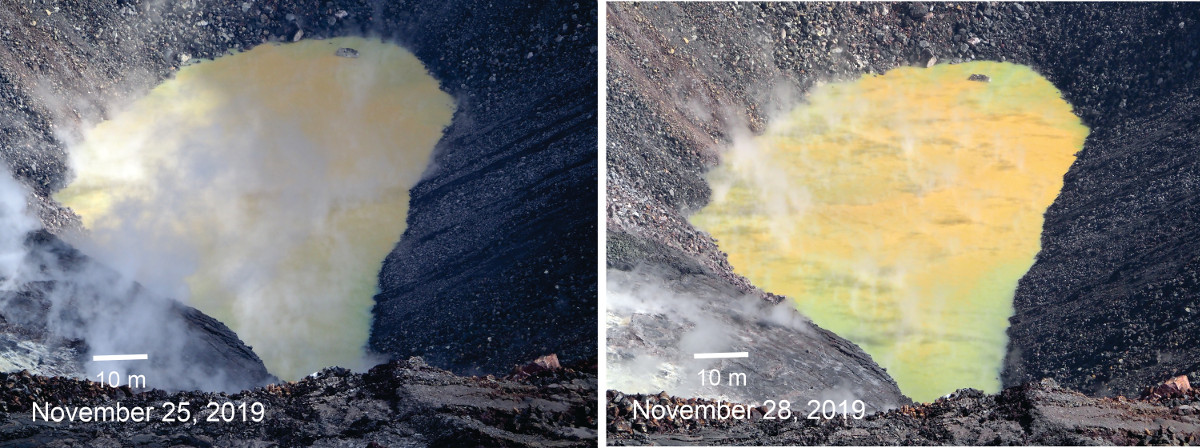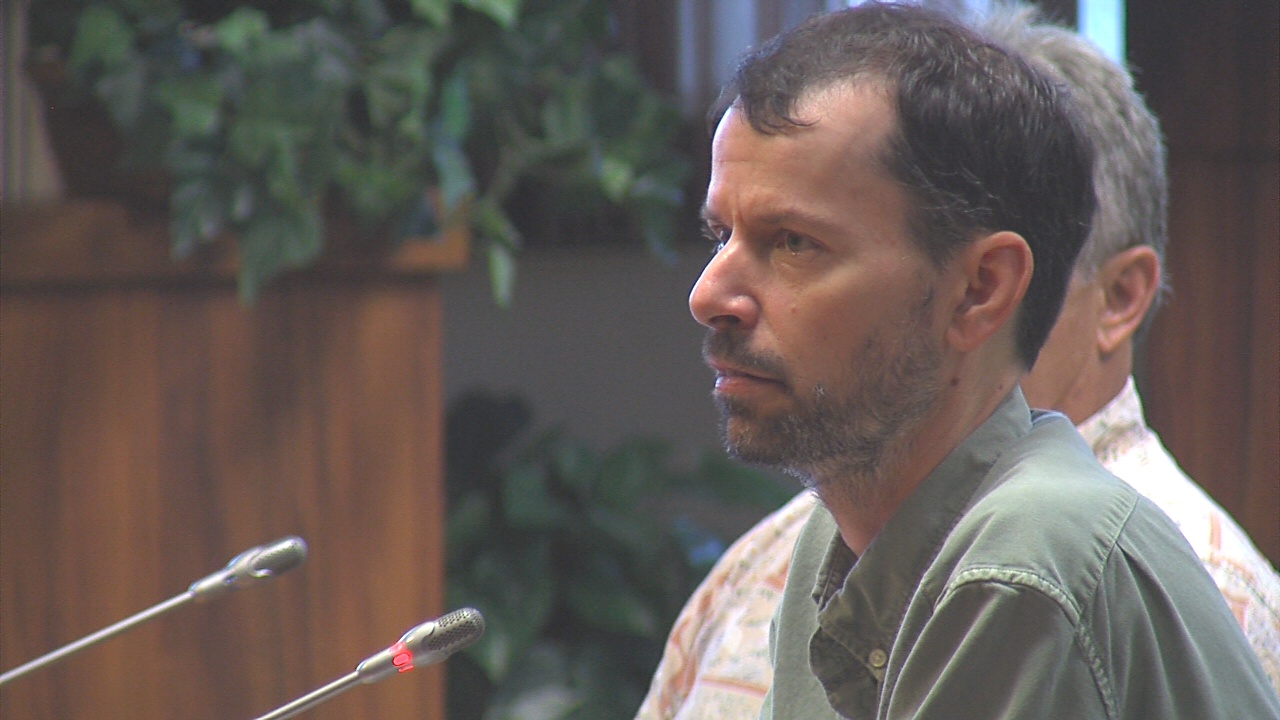
Measured from a vertical distance of about 603 m (1978 ft)—from water surface to the top of the tripod on the crater rim—the dimensions of the crater lake in Halema‘uma‘u were around 71-72 m (233-236 ft) north-south and 157-158 m (515-518 ft) east-west on November 28. The ongoing rise in water level is noticeable when the two photos, taken three days apart, are compared. USGS photos by D. Swanson.
UPDATE (1:30 p.m.) – USGS Hawaiian Volcano Observatory geologist Matt Patrick gave the Hawaiʻi County Council a presentation today on the Halemaʻumaʻu crater lake at the summit of Kīlauea Volcano. One of Patrick’s power point slides stated there are “no detectable signs of imminent unrest at the summit”, and provided the following important points of information:
- Currently, the water pond is stable, with a slow and consistent rise in water level, and no obvious changes in color or surface activity
- Ongoing inflation indicates that the summit magma chamber continues to steadily recharge, and magma remains deep in the system
- Low rates of SO2 emission (45 tonnes per day), but some sulfur is being absorbed by the pond (and groundwater)
- Seismicity is elevated (compared to pre-2018) but has been relatively steady in recent months
Patrick also spoke about the implications of the crater lake for hazards. Magma interacting with water can trigger explosive activity, and according to his presentation:
- In Kīlauea’s geologic record, there is a long history of larger explosions at the summit, that affected the entire summit region.
- Some of these explosions are thought to be triggered by rapidly rising magma interacting with surface water, but the exact conditions that produced the explosive behavior are not clear
- Most likely, explosive activity would be preceded by detectable precursors, such as rapid inflation, or increased seismicity, that indicates magma rising
- However, small gas-driven explosions can occur at volcanic lakes without warning and cannot be ruled out
Hawaiʻi County Civil Defense administrator Talmadge Magno also attended the presentation but made no comments.

USGS HVO geologist Matt Patrick speaks to the Hawaii County Council. Image from video by David Corrigan.
(BIVN) – original story – A Hawaiʻi County Council committee is expecting to hear a presentation today from the U.S. Geological Survey Hawaiian Volcano Observatory, and Hawaiʻi County Civil Defense, on the “source and accumulation of water in Halemaʻumaʻu crater” on the summit of Kīlauea.
Kīlauea Volcano is not erupting, and scientists are presently monitoring the water pond at the bottom of Halema’uma’u, which began forming on July 25, 2019, and which continues to slowly expand and deepen.
The council’s Agriculture, Water, Energy, and Environmental Management Committee meets at 11 a.m. (Tuesday, Dec. 3) in Hilo.
From the November 7th Kīlauea activity update produced by the USGS Hawaiian Volcano Observatory:
A sample of the water collected from the Halema’uma’u water lake by UAS on October 26, 2019 has undergone preliminary analysis. Early results indicate that the sample has a pH of 4.2 (moderately acidic, in the range of many fruit juices) and high concentrations of dissolved sulfur and magnesium. This composition reflects complex processes including reactions between magmatic gases, groundwater (that was recharged as precipitation), and Kilauea’s basaltic rocks (through which the groundwater flows towards the pond). The water’s composition is significantly different from rainwater and is also significantly different from water present in the deep Keller Well 1.5 km (1 mi) south of Halema’uma’u. The difference from Keller Well water suggests that the release of magmatic gases is currently focused under the crater and ponded water, consistent with long term observations at the summit.
Results of the water sample analysis will assist HVO in evaluating potential eruptive hazards posed by Kilauea. For example, the high concentration of dissolved sulfate in the lake water (53,000 mg per liter, 75% of total dissolved solids) suggests that it originates from SO2 released by magma residing at shallow depths below Halema’uma’u. Further work may help constrain that depth.
If much of the SO2 emitted by subsurface magma is being dissolved into the water, current measurements of SO2 emission rate for Kīlauea summit (~30 t/d) are underestimates for true SO2 release from the magma. In the absence of the summit water, SO2 emission rates would likely be higher, perhaps closer to the ~200 t/d emitted prior to the 2008 appearance of the summit lava lake. Future changes in sulfate concentration of the water may indicate changes in SO2 degassing and magma depth.
The lake is also variable in color and temperature. HVO’s single sample of water may not be representative of the lake as a whole. Additional water samples may be necessary to best monitor all aspects of Kīlauea’s current non-eruptive state.

by Big Island Video News7:39 am
on at
STORY SUMMARY
HILO, Hawaiʻi - A council committee has requested a presentation by the USGS and Civil Defense on the accumulation of water at the Kīlauea summit.